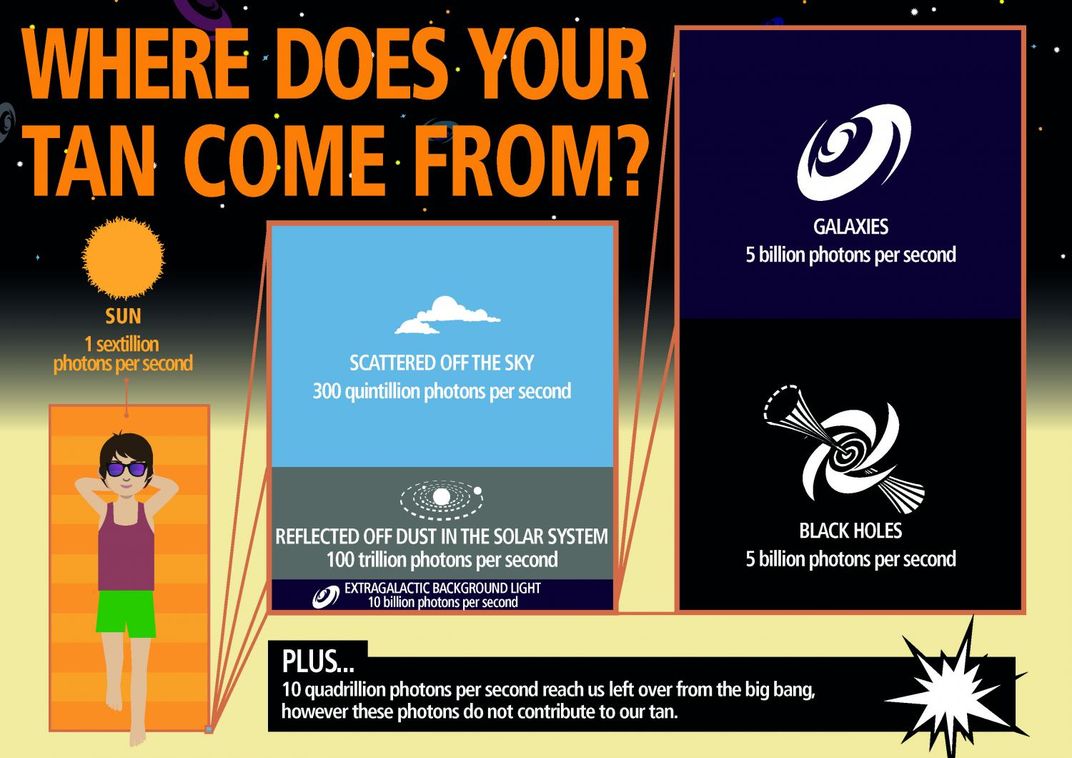Part of Your Suntan Comes From Photons That Are Billions of Years Old
Thank bodies from beyond the galaxy for a bit of that golden glow
/https://tf-cmsv2-smithsonianmag-media.s3.amazonaws.com/filer/16/57/1657899b-a1b4-42eb-a9ff-6e007c4dbe87/14387061164_e6e26489d5_k.jpg)
As summer wanes, you might want to head out to the pool or on a hike to catch even more rays of the sun. As you do, you’ll be bombarded by packets of energy, or photons, straight from the closest star. But new research shows that something else is hitting your skin, too: Photons from intergalactic space.
A new study published in The Astrophysical Journal has quantified just how much light gets to Earth from far-off galaxies and over stretches of billions of years. Using measurements from space telescopes like the NASA Galaxy Evolution Explorer and Wide-Field Infrared Survey Explorer, astronomers measured how much light hits Earth from outside the galaxy—otherwise known as extra-galactic background light.
Light travels at 186,000 miles per second—a speed that, while impressive on Earth, is minuscule when it comes to the huge stretches of space that fill the universe. The vast majority of light that makes it to Earth’s surface comes from the nearby star, which spits out 1,368 watts of power to every square meter of Earth. That radiation is transmitted in packets of energy called photons.

Data from the telescopes showed that a tiny fraction of the sextillion photons of Earth that make it to anywhere on Earth at any given second (ten billion, to be exact) are from outside of the galaxy. “These photons are minted in the cores of stars in distant galaxies, and from matter as it spirals into supermassive black holes,” Simon Driver, the astrophysicist who led the study, says in a release. Since those phenomena are so far outside of our galaxy, it took an extremely long time to reach Earth—billions of years. Some of the photons even come from right around the time that the Big Bang itself burst the universe into life.
If all of this makes you want to reach for your sunscreen, don’t bother—the photons hit Earth day and night, and in the grand scheme of a sextillion, a few billion photons is no big deal. And believe it or not, the universe acts like physical sunblock thanks to space dust, which converts damaging ultraviolet wavelengths of light—the same kind that burn human skin back on Earth—into less ominous energy. The entire system conspires to act like a shield with an SPF of about two. Not bad for a bunch of interstellar junk.
Next, scientists hope to make the numbers even more accurate and perfect their models and methods. Feel free to soak up some intergalactic rays while you wait—just make sure to pack some sunscreen to protect from the heavenly body that can actually burn your skin.
/https://tf-cmsv2-smithsonianmag-media.s3.amazonaws.com/accounts/headshot/erin.png)
/https://tf-cmsv2-smithsonianmag-media.s3.amazonaws.com/accounts/headshot/erin.png)